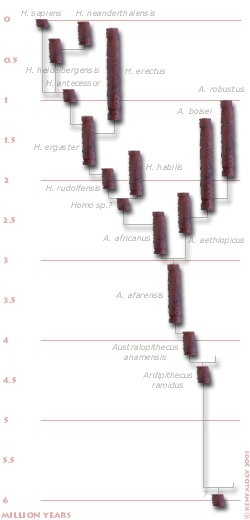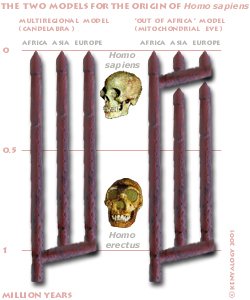|
|
History
In 1911, German entomologist Wilhelm Kattwinkel fell down a ravine while he was chasing an unusual butterfly. The place was Olduvai Gorge, in Serengeti. Somehow Kattwinkel managed to save his life and, when he raised his eyes, he saw something only a scientist would have appreciated: the rocky wall was an extraordinary fossil bed. And this would change the conception man had of his own origins. To explain the history of Kenya we must go right to the start, to the dawn of mankind.
The Cradle of Mankind (4,400,000 B.C.-50,000 B.C.)
Lamarck, Darwin, Wallace, Huxley, Haeckel,... Great names of science whose pioneering theories on the evolution of species and natural selection boosted a revolution in the 19th century Victorian science, since they suggested a common ancestor for man and apes, against the biblical conception of one Creation. Ernst Haeckel postulated the existence of an ape-man, 'Pithecanthropus', who would have inhabited a sunken continent called Lemuria, close to India.
The quest for the "missing link" between man and ape obsessed the Dutch anthropologist Eugène Dubois, who contributed the first evidence for the existence of 'Pithecanthropus' when in 1893 discovered the Man from Java, or 'Pithecanthropus erectus'. The trends of the time, based on this primeval evidence and the Lemuria hypothesis, located the birthplace of Mankind in the Asian continent. Meanwhile, Kattwinkel acted his famous stumble, but it would not be until 1924 that Darwin's theory, which located the "cradle of Mankind" in Africa, started to gain empirical support. That year, Dart and Broom unearthed in South Africa the fossil remains of a pre-hominid, 'Australopithecus africanus', whose age was estimated to be 2 million years, one million older than Dubois' ape-man. New findings started to outline the genealogy of this new genera, of which its possible role as an ancestor of modern man kept on generating discussion during the first three decades of the 20th century.
 In 1931, Dr. Louis Leakey and his fiancée Mary, Kenyans of British origin, endeavoured an extensive study of the Olduvai site that culminated, in 1959, with the discovery of 400 skull fragments of a pre-hominid, 'Zinjanthropus boisei'. The adjacent remains suggested that 'Zinjanthropus''was actually an evolved primate, able to carve stone for making tools. In 1961, the age of 'Zinjanthropus' -afterwards reclassified as 'Australopithecus'- was dated in 1.75 million years. This was the first evidence for the presence of pre-hominids in East Africa, followed by another one of huge relevance: in 1960, the Leakeys found the remains of 'Homo habilis', an evolved hominid capable of carving stone axes, whose age was estimated in 1.4 million years.
In 1931, Dr. Louis Leakey and his fiancée Mary, Kenyans of British origin, endeavoured an extensive study of the Olduvai site that culminated, in 1959, with the discovery of 400 skull fragments of a pre-hominid, 'Zinjanthropus boisei'. The adjacent remains suggested that 'Zinjanthropus''was actually an evolved primate, able to carve stone for making tools. In 1961, the age of 'Zinjanthropus' -afterwards reclassified as 'Australopithecus'- was dated in 1.75 million years. This was the first evidence for the presence of pre-hominids in East Africa, followed by another one of huge relevance: in 1960, the Leakeys found the remains of 'Homo habilis', an evolved hominid capable of carving stone axes, whose age was estimated in 1.4 million years.
The 70's and 80's yielded a boost in paleoanthropological knowledge. Mary Leakey described footprints and fossils of 3.6 million old hominids who lived in the Laetoli area, near Olduvai. On the other hand, her son Richard, with the cooperation of the Kenyan paleonthologist Bernard Ngeneo, explored the Koobi Fora site, close to Lake Turkana, discovering remains of 'Homo habilis' dated 2 million years back. More northwards, Don Johanson and Tim White unearthed in Ethiopia the skeleton of a creature they named Lucy, a female 'Australopithecus' 3.5 million years old, which became the most ancient species of australopithecins known so far: 'Australopithecus afarensis'. Ten years later, in 1984, Richard Leakey achieved a nearly complete reconstruction of a 'Homo erectus' skeleton, the famous Turkana boy, a 1.6 million year old hominid, more evolved according to his cranial capacity and formerly considered a possible direct ancestor of 'Homo sapiens', the modern man. Dubois' 'Pithecanthropus' was assimilated to this same species.
Whilst new australopithecin species were described and the pieces were starting to fall into place, research allowed to draw a panorama which was yet diffuse. Until little more than one million years ago, hominids and pre-hominids were restricted to Southern and Eastern Africa. The two main evolutionary divergent branches, 'Australopithecus' and 'Homo', coexisted until 'Australopithecus', more primitive, became extinct. One million years ago, a few pioneering 'Homo erectus' clans emigrated to Asia. During these early migrations, one 'Homo erectus' reached the Solo river banks, in Java, just to die and be finally discovered, one million years later, by an inquisitive and entrepreneurial scientist named Eugène Dubois.
More recent findings keep the thrill, pushing the origin of pre-hominids further back in history. In 1994, Tim White and Berhane Asfaw dated in 4.4 million years the remains of a new species found in Ethiopia, 'Ardipithecus ramidus'. One year later, at the Turkana site, Meave Leakey, Richard's wife, in cooperation with Alan Walker, discovered what is now the oldest of the australopithecins, 'A. anamensis', an elderly man 4.2 million years old, judged to be the ancestor of 'A. afarensis'. In November 2000, a French-Kenyan team led by doctors Martin Pickford and Brigitte Senut found in Kapsomin, in the Tugen Hills at Baringo district, the remains of fossilized hominids in rock layers 6 million years old.
Concerning the origins of modern man, 'Homo sapiens', our foreparents saw the light some 100,000-140,000 years ago and populated the planet. However, our ancestors' biography is far from complete. Though the study of fossil remains finds today an invaluable support in molecular biology, the book of Mankind's history still has many blank pages. 'H. erectus', who became extinct 100,000 years ago and was formerly considered a direct predecessor of man, seems to be actually a blind alley of a previous species, 'H. ergaster', who was a true ancestor of ours. This species was probably a precursor of the Europeans 'H. heidelbergensis' or Heidelberg Man, extinct some 200,000 years ago, and his successor 'H. neanderthalensis' or Neanderthal Man, who coexisted with 'H. sapiens' and disappeared only 30,000 years ago. But the evolutionary line between our grandfather 'H. ergaster' and us is a matter of discussion among the scientific community, that holds two opposed theories.
 The first genetic evidences supported the hypothesis called "Out of Africa", also named "Mitocondrial Eve", "Noah's Ark" or "Garden of Eden", after which all modern humans have our origin in a small African population that lived 200,000 years ago, and of which only one maternal lineage survived. Hence, all of us would be descendants of a single common mother, whose inheritance we keep in our mitochondrial DNA, the genetic sequences contained in the cellular part that supplies energy, which only the mother transmits to all her progeny. Migration of the descendants of this primeval "Eve" towards Asia and Europe would have resulted in the extinction of the local pre-existing groups, among them the last Asian populations of 'H. erectus' and the European 'H. neanderthalensis', successor to 'H. heidelbergensis'.
The first genetic evidences supported the hypothesis called "Out of Africa", also named "Mitocondrial Eve", "Noah's Ark" or "Garden of Eden", after which all modern humans have our origin in a small African population that lived 200,000 years ago, and of which only one maternal lineage survived. Hence, all of us would be descendants of a single common mother, whose inheritance we keep in our mitochondrial DNA, the genetic sequences contained in the cellular part that supplies energy, which only the mother transmits to all her progeny. Migration of the descendants of this primeval "Eve" towards Asia and Europe would have resulted in the extinction of the local pre-existing groups, among them the last Asian populations of 'H. erectus' and the European 'H. neanderthalensis', successor to 'H. heidelbergensis'.
Opposite to the "Mitochondrial Eve" theory, the invaluable discoveries in Atapuerca (Spain) have lent support to the rival model, called "Multiregional" or "Candelabra". According to this hypothesis, the migratory populations of 'H. erectus' in Asia and Europe developed distinctive anatomical features that persisted over time, what is known as "regional continuity", and what would have originated the racial differences among present-day human populations. Over thousands of years, these separate groups evolved in parallel to one single form we know today as 'H. sapiens'. The contribution of the Atapuerca findings to this model is based on the following: in this mountain range of the Burgos province, the Spanish research team unearthed fossils which were assigned to a novel species, 'H. antecessor', whose oldest remains dated the earliest European 'Homo' 780,000 years ago. If, as is postulated, 'H. antecessor' was a direct ancestor of all European 'Homo' species, including us, then these first dwellers would not have become extinct upon being invaded by 'H. sapiens' from Africa, like the "Mitochondrial Eve" theory would defend, but they would have rather evolved independently towards our species while Asian and African groups did the same.
In this exciting context, and despite we are getting closer to meet our foreparents, paleoanthropologists have not yet achieved to precise which species can be considered as the common ancestors to man and modern apes. Yet today, this primeval man-ape sleeps somewhere beneath the African soil, in a continent which is someway still "Territory Unexplored".
|
|



